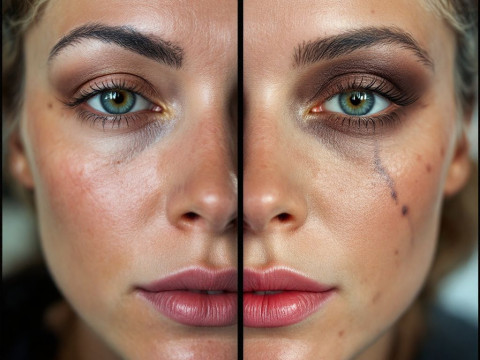Hey, dance parents and performers! You’re probably gearing up for the big day—hair in place, costumes sorted, but what about your skin? It’s often overlooked, but trust me, keeping your skin stage ready is just as crucial as nailing that perfect pirouette.
I’ve seen it on countless occasions: dancers spend countless hours practicing their moves yet forget just how pivotal well-prepped skin is to looking and feeling their best under those bright stage lights. It’s not just vanity—it’s about confidence and authenticity. You want your dancer to feel awesome as they step onto that stage, right? Let’s dig into how we make that happen.
Understanding Stage Lighting and Its Impact
First things first, you’ve got to know your enemy—the lights! Those stage lights are unforgiving, and while they do make performances sparkle, they highlight every little skin imperfection. Brutal, huh? The answer is preparing your skin to withstand all of that intensity.
Heavy lighting tends to wash out complexions, and untreated skin can appear greasy. That’s why managing your skin’s texture and tone is pivotal in event preparation. Having a clean, balanced canvas before applying makeup allows stage-ready makeup to perform better—both in terms of coverage and brightness.
Building a Foundation: Daily Skincare Routine
Think of your skincare ritual as the choreography of skin prep. Daily routines work wonders, not just short-term fixes. Consistency here is key. Just as you wouldn’t practice a dance move once and consider it mastered, skincare thriving under pressure requires dedication.
Step 1: Cleansing Right
Begin with choosing a non-drying cleanser that suits your skin type. If your skin is oily, go for something that removes excess sebum without stripping away all oils. Dry skin? Opt for something hydrating. This lays the initial groundwork for other products to build on.

Step 2: Hydration Is a Must
Healthy skin drinks up moisture. Trust me on this. Invest in a good moisturizer that keeps you hydrated without being heavy. Gels or lightweight creams are usually your best bet because they provide ample hydration without clogging the pores.
Step 3: Skin-Friendly Exfoliation
We’re not talking about the aggressive exfoliation your grandma might have sworn by. Gentle exfoliation helps uncover fresh skin by sloughing off old cells, but don’t overdo it. A good exfoliate once or twice a week works wonders, especially before you begin your makeup application.
Day-of Checklist: Prepping for the Performance
On recital day, every dancer needs something akin to a pre-game ritual, right? Your skin is no exception. Here’s the sequence you’ll want to follow for top-notch results:
Morning Prep
- Clean Slate: Start clean with your typical cleansing routine. It’s the first layer of your defenses.
- Moisturize: Amp up your hydration game. Even oily skin needs moisture before any makeup—just opts for an oil-free variety to avoid unwanted shine.
- Primer is Your Best Friend: Especially under stage-ready makeup. It creates a boundary between your face and the makeup, allowing for a smoother application and increased staying power.
Makeup Made to Last
Ever practiced blends until it’s just perfect? Makeup should be the same—blend until you’re happy. Begin with a foundation that matches your undertone and provides coverage appropriate for stage lights (usually a tad heavier). Use a damp makeup sponge or a foundation brush for best results.

Remember your secondary keywords—here is where they sneak into the conversation. Stage-ready makeup involves a bit of science with the artistic blend. Again, it’s about finding that mix—not too complex, but certainly not careless. Absorbent powder on top can brighten up the look and keeps makeup from melting under those bright beams.
Highlight and Contour: Understand Light and Shadow
You’ll want subtlety here—makeup isn’t just for front-view Instagram shots. Think in three dimensions. Use highlighters on the highest planes of your face and contour where the shadows naturally fall. It emphasizes the right angles, creating a harmonious balance that resonates with the stage lights.
The Magic of Setting Your Look
If there’s any magic potion you need, it’s setting powder or spray. Apply a dusting of setting powder to lock in everything and finish with a setting spray for good measure. It’s akin to setting choreography: once it’s set, it doesn’t drift off into the unknown!
Quick Fixes and Troubleshooting on Performance Day
Okay, here’s the deal—sometimes things don’t go according to plan, but being prepared is half the battle.
- Blotting Papers Are Gold: Keep shine at bay with these little beauties. Carry them in your dance bag for quick touch-ups. No one wants an oily finish ruining their stellar performance.
- miniature products are your saviors: Sample size or travel-size beauty products (think concealers and compact powders) fit easily in your bag. They’re life-savers for midday corrections.
- Emergency Skin-Artillery: Got a pimple that popped up at the last minute? Apply a bit of salicylic treatment under your makeup, or use a solid concealer to diminish its prominence.
Cool-Down Treatments: Post-Performance Care

There’s life after the last bow. It’s like the cool-down in a workout or winding down post-performance. Show your skin some TLC with regenerative, calming steps.
- Cleansing time: Take your time to remove all traces of makeup—the artistry might be over, but you don’t want that staying power to stretch into the next day!
- Hydrate and Heal: Apply calming serums and deep moisturizers to return your skin to a natural state. Dance-life is exhausting; let your creams and masks work their wondrous spells while you drift into a deserved sleep.
- Reflect and Revise: Take a mental note of what went well today and what was a tad off schedule. It’s practice after practice—just like dancing. Each event preparation helps you analyze and improve for the next recital.
It’s More Than Skin Deep
Ultimately, these performance-day rituals integrate seamlessly into broader event preparation strategies by keeping your focus and easing performance jitters. Skin-consciousness is just a component of your holistic gig lens, ensuring you (or your young dancer) face the task with passion and total confidence.
No mess of stage makeup can withstand an unprepared base. Investing a little extra thought into skincare pays dividends once those blinding lights and judgmental audiences appear.
So, what do you say? Ready to shimmy into that recital spotlight with skin that rivals smooth steps and expressive gestures? Make these steps your own, and dance knowing you’re ready—every brim, every shot.
Remember, it’s about harmonizing your entire performance and presentation from tie-breaker skill to esthetic finery. Dancing is an art, and each element counts. Make skin one of them—seamless, bold, and confidently part of the performance narrative. Cheers to that applause waiting right at the curtain call! 🎭
Frequently Asked Questions
What are the key steps in event preparation?
Event preparation involves several key steps, including defining the event’s purpose and goals, determining the type of event, and identifying the target audience. It also includes selecting a venue, managing the budget, scheduling, acquiring necessary permits, coordinating logistics such as transportation and parking, arranging for speakers or entertainers, and ensuring compliance with health and safety standards[3][1][2>.
How do I choose the right venue for my event?
Choosing the right venue involves considering the number of expected attendees, the type of event, and the physical space requirements. You need to think about the layout, whether there are adequate spaces for conversations, and if there are any isolated areas that need monitoring. Additionally, ensure the venue meets your needs for catering, audio-video requirements, and other necessary amenities[1][3][2>.
What are the essential elements to include in an event plan?
An event plan should include the concept and objectives of the event, logistical coordination, and control mechanisms to ensure the event stays on track. It should also cover budgeting, vendor contracts, logistics, marketing, attendee registration, and post-event evaluation. Using frameworks like the 5W1H method (Who, What, When, Where, Why, and How) and the 7 stages of event planning (Research, Design, Planning, Coordination, Evaluation, Implementation, and Follow-up) can help ensure thoroughness[3][1][2>.
How can I ensure the success of a virtual or hybrid event?
For virtual or hybrid events, it is crucial to ensure the content is engaging and condensed. Prepare speakers to deliver their information remotely, and use interactive tools like polls, Q&A sessions, and chat to increase engagement. For hybrid events, decide which content will be available to both virtual and in-person audiences. Also, ensure there is adequate preparation time, clear content from previous sessions, and assign roles to team members to manage the event smoothly[2][4>.
References










